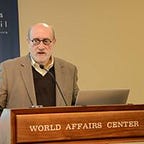28 Presidential decisions that changed history
When we study American history in high school or college, we learn that Thomas Jefferson bought the Louisiana Territory from the French and James Polk launched the Mexican-American War. But what we don’t often learn about are the context in which Presidents Jefferson and Polk made those decisions and the consequences that ensued from them. And that’s the great virtue of Thomas J. Craughwell and Edwin Kiester Jr.’s survey of Presidential decision-making, The Buck Stops Here. In fewer than three hundred extensively illustrated pages, the coauthors cover twenty-eight of the most fateful decisions from George Washington’s suppression of the Whiskey Rebellion in 1794 to Richard Nixon’s visit to China in 1972. Most are instantly familiar, others less so. But in every instance they make the case that these were decisions that changed history, and often in ways that no one had foreseen.
THE MOST CONSEQUENTIAL DECISIONS, NOT THE TOUGHEST
The book’s subtitle refers to “The 28 Toughest Presidential Decisions,” but that’s misleading. No one can possibly know whether the men who made those decisions regarded them as difficult at all. In fact, in a number of cases, it’s clear they didn’t. Because, for example, James K. Polk entered office intent on waging war on Mexico, and FDR was committed from the outset to enact something like the social insurance program that became Social Security. Moreover, the book’s coverage ends with Richard Nixon. They regard the last nine presidents as “too recent for an unbiased assessment of their legacy.” And the coauthors heavily emphasize the twentieth century. (Perhaps that’s because earlier US Presidents usually lacked the power to make such momentous decisions.) The coauthors include four each of Theodore Roosevelt and Franklin Roosevelt’s big decisions, three each of Harry Truman and John F. Kennedy’s, and two of Lyndon Johnson’s.
THE BUCK STOPS HERE: THE 28 TOUGHEST PRESIDENTIAL DECISIONS AND HOW THEY CHANGED HISTORY BY THOMAS J. CRAUGHWELL AND EDWIN KIESTER, JR. (2010) 292 PAGES ★★★★☆
UNSURPRISINGLY, AN EMPHASIS ON PROGRESSIVE CHIEF EXECUTIVES
A thoughtful reader will also note that progressive presidents (the Roosevelts, Truman, Kennedy, Johnson) dominate the story in The Buck Stops Here. But that’s no accident. Progressives who enter office typically do so intent on change. By contrast, conservative presidents such as Warren Harding, Calvin Coolidge, and Herbert Hoover tend to favor nonaction over action. Of course, so-called conservatives such as Ronald Reagan and Donald Trump, who are really reactionary, not conservative, also set out to change things. And any future edition of The Buck Stops Here that covers the most consequential presidential decisions of the past half-century would have to include many of the policies they enacted while in office.
As Craughwell and Kiester argue, “American presidents have tended to come in two varieties: those who believe their primary role is to do nothing more than ‘faithfully execute’ the laws Congress passes and those who believe the chief executive should take a leading role in proposing legislation for Congress to pass.” And that’s as good a definition of the difference between conservatives and progressives as I’ve seen anywhere.
INSIGHTFUL COMMENTARY ON THE CONSEQUENCES
From the outset, the coauthors demonstrate their skill in sussing out the after-effects of each decision. For example, they contend — plausibly — that George Washington’s aggressive move against the Pennsylvania backwoodsmen engaged in the so-called Whiskey Rebellion played a major role in shaping the political environment over the following three decades. “Washington’s action was to doom the Federalist Party,” they write. By humiliating the poor farmers whose livelihood depended on the sale of home-made liquor, and forcing some of them to abandon their stills, Washington helped fuel the rise of Thomas Jefferson’s Democratic-Republican Party, which ruled the roost from 1801 to 1825. The Democratic-Republicans appealed to just such people. And even though few of them qualified as voters under the limited suffrage then in place, the contrast between the aristocratic airs of Washington, Hamilton, and Adams and the democratic pretensions of Jefferson, Burr, and Madison gave voters a clear choice.
ABOUT THE AUTHORS
Thomas J. Craughwell writes about himself on Amazon as follows: “After four years in a doctoral program studying medieval English literature, three years as a copywriter for Book-of-the-Month Club, and one year as a marketing director for a pricey, upscale travel company, I went into business for myself as a full-time writer in 1992. . . As a writer, I really don’t specialize; my resume is all over the map.”
Craughwell’s obituary reveals that he was born in Chicago in 1956 and passed away in 2018. He was the author of more than 35 non-fiction books and a recognized expert on the Roman Catholic Church.
Like his coauthor, Edwin Kiester, Jr. is a professional writer who has written articles and books on a wide variety of topics, most notably on leadership.
For related reading
I’ve also reviewed three other nonfiction books on decision-making:
- Presidents in Crisis: Tough Decisions inside the White House from Truman to Obama by Michael K. Bohn (An eye-opening plunge into Presidential decision-making)
- The Undoing Project: A Friendship That Changed Our Minds by Michael Lewis (Michael Lewis on the science of decision-making)
- National Security and Double Government by Michael J. Glennon (Who makes national security decisions? Not the President!)
You might also be interested in:
- Top 20 popular books for understanding American history
- Top 10 nonfiction books about politics
- 5 top nonfiction books about national security
- 15 good recent books about American foreign policy
And you can always find my most popular reviews, and the most recent ones, on the Home Page of Mal Warwick on Books.
